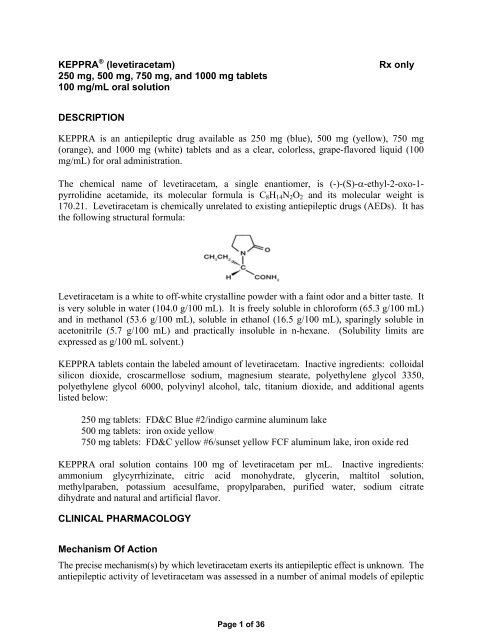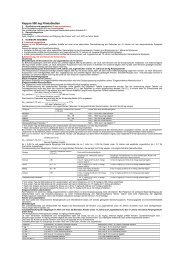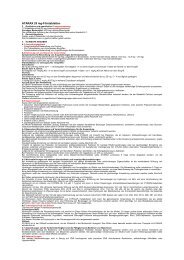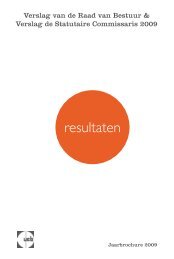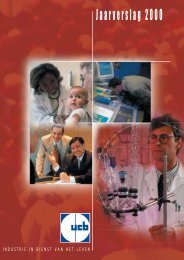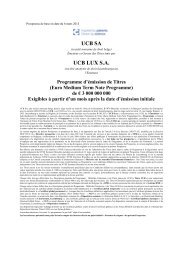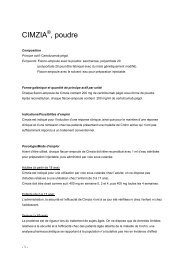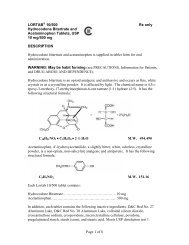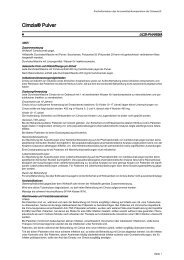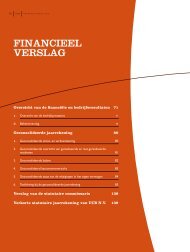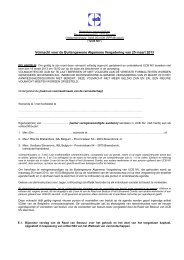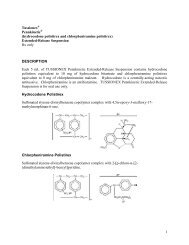KEPPRA (levetiracetam) Rx only 250 mg, 500 mg, 750 mg ... - UCB
KEPPRA (levetiracetam) Rx only 250 mg, 500 mg, 750 mg ... - UCB
KEPPRA (levetiracetam) Rx only 250 mg, 500 mg, 750 mg ... - UCB
Create successful ePaper yourself
Turn your PDF publications into a flip-book with our unique Google optimized e-Paper software.
<strong>KEPPRA</strong> ® (<strong>levetiracetam</strong>) <strong>Rx</strong> <strong>only</strong><br />
<strong>250</strong> <strong>mg</strong>, <strong>500</strong> <strong>mg</strong>, <strong>750</strong> <strong>mg</strong>, and 1000 <strong>mg</strong> tablets<br />
100 <strong>mg</strong>/mL oral solution<br />
DESCRIPTION<br />
<strong>KEPPRA</strong> is an antiepileptic drug available as <strong>250</strong> <strong>mg</strong> (blue), <strong>500</strong> <strong>mg</strong> (yellow), <strong>750</strong> <strong>mg</strong><br />
(orange), and 1000 <strong>mg</strong> (white) tablets and as a clear, colorless, grape-flavored liquid (100<br />
<strong>mg</strong>/mL) for oral administration.<br />
The chemical name of <strong>levetiracetam</strong>, a single enantiomer, is (-)-(S)-α-ethyl-2-oxo-1pyrrolidine<br />
acetamide, its molecular formula is C8H14N2O2 and its molecular weight is<br />
170.21. Levetiracetam is chemically unrelated to existing antiepileptic drugs (AEDs). It has<br />
the following structural formula:<br />
Levetiracetam is a white to off-white crystalline powder with a faint odor and a bitter taste. It<br />
is very soluble in water (104.0 g/100 mL). It is freely soluble in chloroform (65.3 g/100 mL)<br />
and in methanol (53.6 g/100 mL), soluble in ethanol (16.5 g/100 mL), sparingly soluble in<br />
acetonitrile (5.7 g/100 mL) and practically insoluble in n-hexane. (Solubility limits are<br />
expressed as g/100 mL solvent.)<br />
<strong>KEPPRA</strong> tablets contain the labeled amount of <strong>levetiracetam</strong>. Inactive ingredients: colloidal<br />
silicon dioxide, croscarmellose sodium, magnesium stearate, polyethylene glycol 3350,<br />
polyethylene glycol 6000, polyvinyl alcohol, talc, titanium dioxide, and additional agents<br />
listed below:<br />
<strong>250</strong> <strong>mg</strong> tablets: FD&C Blue #2/indigo carmine aluminum lake<br />
<strong>500</strong> <strong>mg</strong> tablets: iron oxide yellow<br />
<strong>750</strong> <strong>mg</strong> tablets: FD&C yellow #6/sunset yellow FCF aluminum lake, iron oxide red<br />
<strong>KEPPRA</strong> oral solution contains 100 <strong>mg</strong> of <strong>levetiracetam</strong> per mL. Inactive ingredients:<br />
ammonium glycyrrhizinate, citric acid monohydrate, glycerin, maltitol solution,<br />
methylparaben, potassium acesulfame, propylparaben, purified water, sodium citrate<br />
dihydrate and natural and artificial flavor.<br />
CLINICAL PHARMACOLOGY<br />
Mechanism Of Action<br />
The precise mechanism(s) by which <strong>levetiracetam</strong> exerts its antiepileptic effect is unknown. The<br />
antiepileptic activity of <strong>levetiracetam</strong> was assessed in a number of animal models of epileptic<br />
Page 1 of 36
seizures. Levetiracetam did not inhibit single seizures induced by maximal stimulation with<br />
electrical current or different chemoconvulsants and showed <strong>only</strong> minimal activity in<br />
submaximal stimulation and in threshold tests. Protection was observed, however, against<br />
secondarily generalized activity from focal seizures induced by pilocarpine and kainic acid,<br />
two chemoconvulsants that induce seizures that mimic some features of human complex<br />
partial seizures with secondary generalization. Levetiracetam also displayed inhibitory<br />
properties in the kindling model in rats, another model of human complex partial seizures,<br />
both during kindling development and in the fully kindled state. The predictive value of these<br />
animal models for specific types of human epilepsy is uncertain.<br />
In vitro and in vivo recordings of epileptiform activity from the hippocampus have shown that<br />
<strong>levetiracetam</strong> inhibits burst firing without affecting normal neuronal excitability, suggesting that<br />
<strong>levetiracetam</strong> may selectively prevent hypersynchronization of epileptiform burst firing and<br />
propagation of seizure activity.<br />
Levetiracetam at concentrations of up to 10 μM did not demonstrate binding affinity for a<br />
variety of known receptors, such as those associated with benzodiazepines, GABA (gammaaminobutyric<br />
acid), glycine, NMDA (N-methyl-D-aspartate), re-uptake sites, and second<br />
messenger systems. Furthermore, in vitro studies have failed to find an effect of<br />
<strong>levetiracetam</strong> on neuronal voltage-gated sodium or T-type calcium currents and <strong>levetiracetam</strong><br />
does not appear to directly facilitate GABAergic neurotransmission. However, in vitro<br />
studies have demonstrated that <strong>levetiracetam</strong> opposes the activity of negative modulators of<br />
GABA- and glycine-gated currents and partially inhibits N-type calcium currents in neuronal<br />
cells.<br />
A saturable and stereoselective neuronal binding site in rat brain tissue has been described for<br />
<strong>levetiracetam</strong>. Experimental data indicate that this binding site is the synaptic vesicle protein<br />
SV2A, thought to be involved in the regulation of vesicle exocytosis. Although the molecular<br />
significance of <strong>levetiracetam</strong> binding to synaptic vesicle protein SV2A is not understood,<br />
<strong>levetiracetam</strong> and related analogs showed a rank order of affinity for SV2A which correlated<br />
with the potency of their antiseizure activity in audiogenic seizure-prone mice. These<br />
findings suggest that the interaction of <strong>levetiracetam</strong> with the SV2A protein may contribute to<br />
the antiepileptic mechanism of action of the drug.<br />
Pharmacokinetics<br />
The pharmacokinetics of <strong>levetiracetam</strong> have been studied in healthy adult subjects, adults and<br />
pediatric patients with epilepsy, elderly subjects and subjects with renal and hepatic<br />
impairment.<br />
Overview<br />
Levetiracetam is rapidly and almost completely absorbed after oral administration.<br />
Levetiracetam tablets and oral solution are bioequivalent. The pharmacokinetics are linear<br />
and time-invariant, with low intra- and inter-subject variability. The extent of bioavailability<br />
of <strong>levetiracetam</strong> is not affected by food. Levetiracetam is not significantly protein-bound<br />
(
major metabolic pathway of <strong>levetiracetam</strong> (24% of dose) is an enzymatic hydrolysis of the<br />
acetamide group. It is not liver cytochrome P450 dependent. The metabolites have no<br />
known pharmacological activity and are renally excreted. Plasma half-life of <strong>levetiracetam</strong><br />
across studies is approximately 6-8 hours. It is increased in the elderly (primarily due to<br />
impaired renal clearance) and in subjects with renal impairment.<br />
Absorption And Distribution<br />
Absorption of <strong>levetiracetam</strong> is rapid, with peak plasma concentrations occurring in about an<br />
hour following oral administration in fasted subjects. The oral bioavailability of<br />
<strong>levetiracetam</strong> tablets is 100% and the tablets and oral solution are bioequivalent in rate and<br />
extent of absorption. Food does not affect the extent of absorption of <strong>levetiracetam</strong> but it<br />
decreases Cmax by 20% and delays Tmax by 1.5 hours. The pharmacokinetics of <strong>levetiracetam</strong><br />
are linear over the dose range of <strong>500</strong>-<strong>500</strong>0 <strong>mg</strong>. Steady state is achieved after 2 days of<br />
multiple twice-daily dosing. Levetiracetam and its major metabolite are less than 10% bound<br />
to plasma proteins; clinically significant interactions with other drugs through competition for<br />
protein binding sites are therefore unlikely.<br />
Metabolism<br />
Levetiracetam is not extensively metabolized in humans. The major metabolic pathway is the<br />
enzymatic hydrolysis of the acetamide group, which produces the carboxylic acid metabolite,<br />
ucb L057 (24% of dose) and is not dependent on any liver cytochrome P450 isoenzymes.<br />
The major metabolite is inactive in animal seizure models. Two minor metabolites were<br />
identified as the product of hydroxylation of the 2-oxo-pyrrolidine ring (2% of dose) and<br />
opening of the 2-oxo-pyrrolidine ring in position 5 (1% of dose). There is no enantiomeric<br />
interconversion of <strong>levetiracetam</strong> or its major metabolite.<br />
Elimination<br />
Levetiracetam plasma half-life in adults is 7 ± 1 hour and is unaffected by either dose or<br />
repeated administration. Levetiracetam is eliminated from the systemic circulation by renal<br />
excretion as unchanged drug which represents 66% of administered dose. The total body<br />
clearance is 0.96 mL/min/kg and the renal clearance is 0.6 mL/min/kg. The mechanism of<br />
excretion is glomerular filtration with subsequent partial tubular reabsorption. The metabolite<br />
ucb L057 is excreted by glomerular filtration and active tubular secretion with a renal<br />
clearance of 4 mL/min/kg. Levetiracetam elimination is correlated to creatinine clearance.<br />
Levetiracetam clearance is reduced in patients with impaired renal function (see Special<br />
Populations, Renal Impairment and DOSAGE AND ADMINISTRATION, Adult Patients<br />
With Impaired Renal Function).<br />
Pharmacokinetic Interactions<br />
In vitro data on metabolic interactions indicate that <strong>levetiracetam</strong> is unlikely to produce, or be<br />
subject to, pharmacokinetic interactions. Levetiracetam and its major metabolite, at<br />
concentrations well above Cmax levels achieved within the therapeutic dose range, are neither<br />
inhibitors of, nor high affinity substrates for, human liver cytochrome P450 isoforms, epoxide<br />
hydrolase or UDP-glucuronidation enzymes. In addition, <strong>levetiracetam</strong> does not affect the in<br />
vitro glucuronidation of valproic acid.<br />
Page 3 of 36
Potential pharmacokinetic interactions of or with <strong>levetiracetam</strong> were assessed in clinical<br />
pharmacokinetic studies (phenytoin, valproate, warfarin, digoxin, oral contraceptive,<br />
probenecid) and through pharmacokinetic screening in the placebo-controlled clinical studies<br />
in epilepsy patients (see PRECAUTIONS, Drug Interactions).<br />
Special Populations<br />
Elderly<br />
Pharmacokinetics of <strong>levetiracetam</strong> were evaluated in 16 elderly subjects (age 61-88 years)<br />
with creatinine clearance ranging from 30 to 74 mL/min. Following oral administration of<br />
twice-daily dosing for 10 days, total body clearance decreased by 38% and the half-life was<br />
2.5 hours longer in the elderly compared to healthy adults. This is most likely due to the<br />
decrease in renal function in these subjects.<br />
Pediatric Patients<br />
Pharmacokinetics of <strong>levetiracetam</strong> were evaluated in 24 pediatric patients (age 6-12 years)<br />
after single dose (20 <strong>mg</strong>/kg). The body weight adjusted apparent clearance of <strong>levetiracetam</strong><br />
was approximately 40% higher than in adults.<br />
A repeat dose pharmacokinetic study was conducted in pediatric patients (age 4-12 years) at<br />
doses of 20 <strong>mg</strong>/kg/day, 40 <strong>mg</strong>/kg/day, and 60 <strong>mg</strong>/kg/day. The evaluation of the<br />
pharmacokinetic profile of <strong>levetiracetam</strong> and its metabolite (ucb L057) in 14 pediatric<br />
patients demonstrated rapid absorption of <strong>levetiracetam</strong> at all doses with a Tmax of about 1<br />
hour and a t1/2 of 5 hours across the three dosing levels. The pharmacokinetics of<br />
<strong>levetiracetam</strong> in children was linear between 20 to 60 <strong>mg</strong>/kg/day. The potential interaction of<br />
<strong>levetiracetam</strong> with other AEDs was also evaluated in these patients (see PRECAUTIONS,<br />
Drug Interactions). Levetiracetam had no significant effect on the plasma concentrations of<br />
carbamazepine, valproic acid, topiramate or lamotrigine. However, there was about a 22%<br />
increase of apparent clearance of <strong>levetiracetam</strong> when it was co-administered with an enzymeinducing<br />
AED (e.g. carbamazepine). Population pharmacokinetic analysis showed that body<br />
weight was significantly correlated to clearance of <strong>levetiracetam</strong> in pediatric patients;<br />
clearance increased with an increase in body weight.<br />
Gender<br />
Levetiracetam Cmax and AUC were 20% higher in women (N=11) compared to men (N=12).<br />
However, clearances adjusted for body weight were comparable.<br />
Race<br />
Formal pharmacokinetic studies of the effects of race have not been conducted. Cross study<br />
comparisons involving Caucasians (N=12) and Asians (N=12), however, show that<br />
pharmacokinetics of <strong>levetiracetam</strong> were comparable between the two races. Because<br />
<strong>levetiracetam</strong> is primarily renally excreted and there are no important racial differences in<br />
creatinine clearance, pharmacokinetic differences due to race are not expected.<br />
Renal Impairment<br />
The disposition of <strong>levetiracetam</strong> was studied in adult subjects with varying degrees of renal<br />
function. Total body clearance of <strong>levetiracetam</strong> is reduced in patients with impaired renal<br />
Page 4 of 36
function by 40% in the mild group (CLcr = 50-80 mL/min), 50% in the moderate group<br />
(CLcr = 30-50 mL/min) and 60% in the severe renal impairment group (CLcr 80mL/min). Approximately 50% of the pool of <strong>levetiracetam</strong> in<br />
the body is removed during a standard 4-hour hemodialysis procedure.<br />
Dosage should be reduced in patients with impaired renal function receiving <strong>levetiracetam</strong>,<br />
and supplemental doses should be given to patients after dialysis (see PRECAUTIONS and<br />
DOSAGE AND ADMINISTRATION, Adult Patients With Impaired Renal Function).<br />
Hepatic Impairment<br />
In subjects with mild (Child-Pugh A) to moderate (Child-Pugh B) hepatic impairment, the<br />
pharmacokinetics of <strong>levetiracetam</strong> were unchanged. In patients with severe hepatic<br />
impairment (Child-Pugh C), total body clearance was 50% that of normal subjects, but<br />
decreased renal clearance accounted for most of the decrease. No dose adjustment is needed<br />
for patients with hepatic impairment.<br />
CLINICAL STUDIES<br />
In the following studies, statistical significance versus placebo indicates a p value < 0.05.<br />
Effectiveness In Partial Onset Seizures In Adults With Epilepsy<br />
The effectiveness of <strong>KEPPRA</strong> as adjunctive therapy (added to other antiepileptic drugs) in<br />
adults was established in three multicenter, randomized, double-blind, placebo-controlled<br />
clinical studies in patients who had refractory partial onset seizures with or without secondary<br />
generalization. The tablet formulation was used in all these studies. In these studies, 904<br />
patients were randomized to placebo, 1000 <strong>mg</strong>, 2000 <strong>mg</strong>, or 3000 <strong>mg</strong>/day. Patients enrolled<br />
in Study 1 or Study 2 had refractory partial onset seizures for at least two years and had taken<br />
two or more classical AEDs. Patients enrolled in Study 3 had refractory partial onset seizures<br />
for at least 1 year and had taken one classical AED. At the time of the study, patients were<br />
taking a stable dose regimen of at least one and could take a maximum of two AEDs. During<br />
the baseline period, patients had to have experienced at least two partial onset seizures during<br />
each 4-week period.<br />
Study 1<br />
Study 1 was a double-blind, placebo-controlled, parallel-group study conducted at 41 sites in<br />
the United States comparing <strong>KEPPRA</strong> 1000 <strong>mg</strong>/day (N=97), <strong>KEPPRA</strong> 3000 <strong>mg</strong>/day<br />
(N=101), and placebo (N=95) given in equally divided doses twice daily. After a prospective<br />
baseline period of 12 weeks, patients were randomized to one of the three treatment groups<br />
described above. The 18-week treatment period consisted of a 6-week titration period,<br />
followed by a 12-week fixed dose evaluation period, during which concomitant AED<br />
regimens were held constant. The primary measure of effectiveness was a between group<br />
comparison of the percent reduction in weekly partial seizure frequency relative to placebo<br />
Page 5 of 36
over the entire randomized treatment period (titration + evaluation period). Secondary<br />
outcome variables included the responder rate (incidence of patients with ≥50% reduction<br />
from baseline in partial onset seizure frequency). The results of the analysis of Study 1 are<br />
displayed in Table 1.<br />
Table 1: Reduction In Mean Over Placebo In Weekly Frequency Of Partial Onset Seizures In<br />
Study 1<br />
Placebo<br />
(N=95)<br />
Page 6 of 36<br />
<strong>KEPPRA</strong><br />
1000 <strong>mg</strong>/day<br />
(N=97)<br />
<strong>KEPPRA</strong><br />
3000 <strong>mg</strong>/day<br />
(N=101)<br />
Percent reduction in partial<br />
seizure frequency over<br />
placebo<br />
– 26.1%* 30.1%*<br />
*statistically significant versus placebo<br />
The percentage of patients (y-axis) who achieved ≥50% reduction in weekly seizure rates<br />
from baseline in partial onset seizure frequency over the entire randomized treatment period<br />
(titration + evaluation period) within the three treatment groups (x-axis) is presented in Figure<br />
1.<br />
Figure 1: Responder Rate (≥50% Reduction From Baseline) In Study 1<br />
% of Patients<br />
45%<br />
40%<br />
35%<br />
30%<br />
25%<br />
20%<br />
15%<br />
10%<br />
5%<br />
0%<br />
7.4%<br />
37.1%<br />
Placebo (N=95) <strong>KEPPRA</strong> 1000 <strong>mg</strong>/day<br />
(N=97)<br />
*statistically significant versus placebo<br />
Study 2<br />
*<br />
39.6%<br />
*<br />
<strong>KEPPRA</strong> 3000 <strong>mg</strong>/day<br />
(N=101)<br />
Study 2 was a double-blind, placebo-controlled, crossover study conducted at 62 centers in<br />
Europe comparing <strong>KEPPRA</strong> 1000 <strong>mg</strong>/day (N=106), <strong>KEPPRA</strong> 2000 <strong>mg</strong>/day (N=105), and<br />
placebo (N=111) given in equally divided doses twice daily.
The first period of the study (Period A) was designed to be analyzed as a parallel-group<br />
study. After a prospective baseline period of up to 12 weeks, patients were randomized to<br />
one of the three treatment groups described above. The 16-week treatment period consisted<br />
of the 4-week titration period followed by a 12-week fixed dose evaluation period, during<br />
which concomitant AED regimens were held constant. The primary measure of effectiveness<br />
was a between group comparison of the percent reduction in weekly partial seizure frequency<br />
relative to placebo over the entire randomized treatment period (titration + evaluation period).<br />
Secondary outcome variables included the responder rate (incidence of patients with ≥50%<br />
reduction from baseline in partial onset seizure frequency). The results of the analysis of<br />
Period A are displayed in Table 2.<br />
Table 2: Reduction In Mean Over Placebo In Weekly Frequency Of Partial Onset Seizures In<br />
Study 2: Period A<br />
Placebo<br />
(N=111)<br />
Percent reduction in partial<br />
seizure frequency over<br />
–<br />
placebo<br />
*statistically significant versus placebo<br />
Page 7 of 36<br />
<strong>KEPPRA</strong><br />
1000 <strong>mg</strong>/day<br />
(N=106)<br />
17.1%*<br />
<strong>KEPPRA</strong><br />
2000 <strong>mg</strong>/day<br />
(N=105)<br />
21.4%*<br />
The percentage of patients (y-axis) who achieved ≥50% reduction in weekly seizure rates<br />
from baseline in partial onset seizure frequency over the entire randomized treatment period<br />
(titration + evaluation period) within the three treatment groups (x-axis) is presented in Figure<br />
2.<br />
Figure 2: Responder Rate (≥50% Reduction From Baseline) In Study 2: Period A<br />
% of Patients<br />
45%<br />
40%<br />
35%<br />
30%<br />
25%<br />
20%<br />
15%<br />
10%<br />
5%<br />
0%<br />
6.3%<br />
20.8%<br />
Placebo (N=111) <strong>KEPPRA</strong> 1000 <strong>mg</strong>/day<br />
(N=106)<br />
*statistically significant versus placebo<br />
*<br />
35.2%<br />
*<br />
<strong>KEPPRA</strong> 2000 <strong>mg</strong>/day<br />
(N=105)<br />
The comparison of <strong>KEPPRA</strong> 2000 <strong>mg</strong>/day to <strong>KEPPRA</strong> 1000 <strong>mg</strong>/day for responder rate was<br />
statistically significant (P=0.02). Analysis of the trial as a cross-over yielded similar results.
Study 3<br />
Study 3 was a double-blind, placebo-controlled, parallel-group study conducted at 47 centers<br />
in Europe comparing <strong>KEPPRA</strong> 3000 <strong>mg</strong>/day (N=180) and placebo (N=104) in patients with<br />
refractory partial onset seizures, with or without secondary generalization, receiving <strong>only</strong> one<br />
concomitant AED. Study drug was given in two divided doses. After a prospective baseline<br />
period of 12 weeks, patients were randomized to one of two treatment groups described<br />
above. The 16-week treatment period consisted of a 4-week titration period, followed by a<br />
12-week fixed dose evaluation period, during which concomitant AED doses were held<br />
constant. The primary measure of effectiveness was a between group comparison of the<br />
percent reduction in weekly seizure frequency relative to placebo over the entire randomized<br />
treatment period (titration + evaluation period). Secondary outcome variables included the<br />
responder rate (incidence of patients with ≥50% reduction from baseline in partial onset<br />
seizure frequency). Table 3 displays the results of the analysis of Study 3.<br />
Table 3: Reduction In Mean Over Placebo In Weekly Frequency Of Partial Onset Seizures In<br />
Study 3<br />
Percent reduction in partial seizure<br />
frequency over placebo<br />
*statistically significant versus placebo<br />
Placebo<br />
(N=104)<br />
Page 8 of 36<br />
<strong>KEPPRA</strong><br />
3000 <strong>mg</strong>/day<br />
(N=180)<br />
– 23.0%*<br />
The percentage of patients (y-axis) who achieved ≥50% reduction in weekly seizure rates<br />
from baseline in partial onset seizure frequency over the entire randomized treatment period<br />
(titration + evaluation period) within the two treatment groups (x-axis) is presented in Figure<br />
3.<br />
Figure 3: Responder Rate (≥50% Reduction From Baseline) In Study 3<br />
% of Patients<br />
45%<br />
40%<br />
35%<br />
30%<br />
25%<br />
20%<br />
15%<br />
10%<br />
5%<br />
0%<br />
14.4%<br />
39.4%<br />
Placebo (N=104) <strong>KEPPRA</strong> 3000 <strong>mg</strong>/day (N=180)<br />
*statistically significant versus placebo<br />
*
Effectiveness In Partial Onset Seizures In Pediatric Patients With Epilepsy<br />
The effectiveness of <strong>KEPPRA</strong> as adjunctive therapy (added to other antiepileptic drugs) in<br />
pediatric patients was established in one multicenter, randomized double-blind, placebocontrolled<br />
study, conducted at 60 sites in North America, in children 4 to 16 years of age with<br />
partial seizures uncontrolled by standard antiepileptic drugs (AEDs). Eligible patients on a<br />
stable dose of 1-2 AEDs, who still experienced at least 4 partial onset seizures during the 4<br />
weeks prior to screening, as well as at least 4 partial onset seizures in each of the two 4-week<br />
baseline periods, were randomized to receive either <strong>KEPPRA</strong> or placebo. The enrolled<br />
population included 198 patients (<strong>KEPPRA</strong> N=101, placebo N=97) with refractory partial<br />
onset seizures, whether or not secondarily generalized. The study consisted of an 8-week<br />
baseline period and 4-week titration period followed by a 10-week evaluation period. Dosing<br />
was initiated at a dose of 20 <strong>mg</strong>/kg/day in two divided doses. During the treatment period,<br />
<strong>KEPPRA</strong> doses were adjusted in 20 <strong>mg</strong>/kg/day increments, at 2-week intervals to the target<br />
dose of 60 <strong>mg</strong>/kg/day. The primary measure of effectiveness was a between group<br />
comparison of the percent reduction in weekly partial seizure frequency relative to placebo<br />
over the entire 14-week randomized treatment period (titration + evaluation period).<br />
Secondary outcome variables included the responder rate (incidence of patients with ≥ 50%<br />
reduction from baseline in partial onset seizure frequency per week). Table 4 displays the<br />
results of this study.<br />
Table 4: Reduction In Mean Over Placebo In Weekly Frequency Of Partial Onset Seizures<br />
Percent reduction in partial seizure<br />
frequency over placebo<br />
*statistically significant versus placebo<br />
Placebo<br />
(N=97)<br />
Page 9 of 36<br />
<strong>KEPPRA</strong><br />
(N=101)<br />
- 26.8%*<br />
The percentage of patients (y-axis) who achieved ≥ 50% reduction in weekly seizure rates<br />
from baseline in partial onset seizure frequency over the entire randomized treatment period<br />
(titration + evaluation period) within the two treatment groups (x-axis) is presented in Figure<br />
4.<br />
Figure 4: Responder Rate (≥ 50% Reduction From Baseline)
% of Patients<br />
45%<br />
40%<br />
35%<br />
30%<br />
25%<br />
20%<br />
15%<br />
10%<br />
5%<br />
0%<br />
19.6%<br />
44.6%<br />
Placebo (N=97) <strong>KEPPRA</strong> (N=101)<br />
*statistically significant versus placebo<br />
*<br />
Effectiveness In Myoclonic Seizures In Patients ≥12 Years Of Age With<br />
Juvenile Myoclonic Epilepsy (JME)<br />
The effectiveness of <strong>KEPPRA</strong> as adjunctive therapy (added to other antiepileptic drugs) in<br />
patients 12 years of age and older with juvenile myoclonic epilepsy (JME) experiencing<br />
myoclonic seizures was established in one multicenter, randomized, double-blind, placebocontrolled<br />
study, conducted at 37 sites in 14 countries. Of the 120 patients enrolled, 113 had<br />
a diagnosis of confirmed or suspected JME. Eligible patients on a stable dose of 1<br />
antiepileptic drug (AED) experiencing one or more myoclonic seizures per day for at least 8<br />
days during the prospective 8-week baseline period were randomized to either <strong>KEPPRA</strong> or<br />
placebo (<strong>KEPPRA</strong> N=60, placebo N=60). Patients were titrated over 4 weeks to a target dose<br />
of 3000 <strong>mg</strong>/day and treated at a stable dose of 3000 <strong>mg</strong>/day over 12 weeks (evaluation<br />
period). Study drug was given in 2 divided doses.<br />
The primary measure of effectiveness was the proportion of patients with at least 50%<br />
reduction in the number of days per week with one or more myoclonic seizures during the<br />
treatment period (titration + evaluation periods) as compared to baseline. Table 5 displays<br />
the results for the 113 patients with JME in this study.<br />
Table 5: Responder Rate (≥50% Reduction From Baseline) In Myoclonic Seizure Days Per<br />
Week for Patients with JME<br />
Placebo<br />
(N=59)<br />
Page 10 of 36<br />
<strong>KEPPRA</strong><br />
(N=54)<br />
Percentage of responders 23.7% 60.4%*<br />
*statistically significant versus placebo
Effectiveness For Primary Generalized Tonic-Clonic Seizures In Patients ≥6<br />
Years Of Age<br />
The effectiveness of <strong>KEPPRA</strong> as adjunctive therapy (added to other antiepileptic drugs) in<br />
patients 6 years of age and older with idiopathic generalized epilepsy experiencing primary<br />
generalized tonic-clonic (PGTC) seizures was established in one multicenter, randomized,<br />
double-blind, placebo-controlled study, conducted at 50 sites in 8 countries. Eligible patients<br />
on a stable dose of 1 or 2 antiepileptic drugs (AEDs) experiencing at least 3 PGTC seizures<br />
during the 8-week combined baseline period (at least one PGTC seizure during the 4 weeks<br />
prior to the prospective baseline period and at least one PGTC seizure during the 4-week<br />
prospective baseline period) were randomized to either <strong>KEPPRA</strong> or placebo. The 8-week<br />
combined baseline period is referred to as “baseline” in the remainder of this section. The<br />
population included 164 patients (<strong>KEPPRA</strong> N=80, placebo N=84) with idiopathic generalized<br />
epilepsy (predominately juvenile myoclonic epilepsy, juvenile absence epilepsy, childhood<br />
absence epilepsy, or epilepsy with Grand Mal seizures on awakening) experiencing primary<br />
generalized tonic-clonic seizures. Each of these syndromes of idiopathic generalized epilepsy<br />
was well represented in this patient population. Patients were titrated over 4 weeks to a target<br />
dose of 3000 <strong>mg</strong>/day for adults or a pediatric target dose of 60 <strong>mg</strong>/kg/day and treated at a<br />
stable dose of 3000 <strong>mg</strong>/day (or 60 <strong>mg</strong>/kg/day for children) over 20 weeks (evaluation period).<br />
Study drug was given in 2 equally divided doses per day.<br />
The primary measure of effectiveness was the percent reduction from baseline in weekly<br />
PGTC seizure frequency for <strong>KEPPRA</strong> and placebo treatment groups over the treatment<br />
period (titration + evaluation periods). There was a statistically significant decrease from<br />
baseline in PGTC frequency in the <strong>KEPPRA</strong>-treated patients compared to the placebo-treated<br />
patients.<br />
Table 6: Median Percent Reduction From Baseline In PGTC Seizure Frequency Per Week<br />
Percent reduction in PGTC seizure<br />
frequency<br />
*statistically significant versus placebo<br />
Placebo<br />
(N=84)<br />
Page 11 of 36<br />
<strong>KEPPRA</strong><br />
(N=78)<br />
44.6% 77.6%*<br />
The percentage of patients (y-axis) who achieved ≥50% reduction in weekly seizure rates<br />
from baseline in PGTC seizure frequency over the entire randomized treatment period<br />
(titration + evaluation period) within the two treatment groups (x-axis) is presented in Figure<br />
5.<br />
Figure 5: Responder Rate (≥50% Reduction From Baseline) In PGTC Seizure Frequency Per<br />
Week
% of Patients<br />
100%<br />
90%<br />
80%<br />
70%<br />
60%<br />
50%<br />
40%<br />
30%<br />
20%<br />
10%<br />
0%<br />
45.2%<br />
72.2%<br />
Placebo (N=84) <strong>KEPPRA</strong> (N=79)<br />
*statistically significant versus placebo<br />
INDICATIONS AND USAGE<br />
*<br />
<strong>KEPPRA</strong> is indicated as adjunctive therapy in the treatment of partial onset seizures in adults<br />
and children 4 years of age and older with epilepsy.<br />
<strong>KEPPRA</strong> is indicated as adjunctive therapy in the treatment of myoclonic seizures in adults<br />
and adolescents 12 years of age and older with juvenile myoclonic epilepsy.<br />
<strong>KEPPRA</strong> is indicated as adjunctive therapy in the treatment of primary generalized tonicclonic<br />
seizures in adults and children 6 years of age and older with idiopathic generalized<br />
epilepsy.<br />
CONTRAINDICATIONS<br />
This product should not be administered to patients who have previously exhibited<br />
hypersensitivity to <strong>levetiracetam</strong> or any of the inactive ingredients in <strong>KEPPRA</strong> tablets or oral<br />
solution.<br />
Page 12 of 36
WARNINGS<br />
Neuropsychiatric Adverse Events<br />
Partial Onset Seizures<br />
Adults<br />
In adults experiencing partial onset seizures, <strong>KEPPRA</strong> use is associated with the occurrence<br />
of central nervous system adverse events that can be classified into the following categories:<br />
1) somnolence and fatigue, 2) coordination difficulties, and 3) behavioral abnormalities.<br />
In controlled trials of adult patients with epilepsy experiencing partial onset seizures, 14.8%<br />
of <strong>KEPPRA</strong>-treated patients reported somnolence, compared to 8.4% of placebo patients.<br />
There was no clear dose response up to 3000 <strong>mg</strong>/day. In a study where there was no titration,<br />
about 45% of patients receiving 4000 <strong>mg</strong>/day reported somnolence. The somnolence was<br />
considered serious in 0.3% of the treated patients, compared to 0% in the placebo group.<br />
About 3% of <strong>KEPPRA</strong>-treated patients discontinued treatment due to somnolence, compared<br />
to 0.7% of placebo patients. In 1.4% of treated patients and in 0.9% of placebo patients the<br />
dose was reduced, while 0.3% of the treated patients were hospitalized due to somnolence.<br />
In controlled trials of adult patients with epilepsy experiencing partial onset seizures, 14.7%<br />
of treated patients reported asthenia, compared to 9.1% of placebo patients. Treatment was<br />
discontinued in 0.8% of treated patients as compared to 0.5% of placebo patients. In 0.5% of<br />
treated patients and in 0.2% of placebo patients the dose was reduced.<br />
A total of 3.4% of <strong>KEPPRA</strong>-treated patients experienced coordination difficulties, (reported<br />
as either ataxia, abnormal gait, or incoordination) compared to 1.6% of placebo patients. A<br />
total of 0.4% of patients in controlled trials discontinued <strong>KEPPRA</strong> treatment due to ataxia,<br />
compared to 0% of placebo patients. In 0.7% of treated patients and in 0.2% of placebo<br />
patients the dose was reduced due to coordination difficulties, while one of the treated<br />
patients was hospitalized due to worsening of pre-existing ataxia.<br />
Somnolence, asthenia and coordination difficulties occurred most frequently within the first 4<br />
weeks of treatment.<br />
In controlled trials of patients with epilepsy experiencing partial onset seizures, 5 (0.7%) of<br />
<strong>KEPPRA</strong>-treated patients experienced psychotic symptoms compared to 1 (0.2%) placebo<br />
patient. Two (0.3%) <strong>KEPPRA</strong>-treated patients were hospitalized and their treatment was<br />
discontinued. Both events, reported as psychosis, developed within the first week of<br />
treatment and resolved within 1 to 2 weeks following treatment discontinuation. Two other<br />
events, reported as hallucinations, occurred after 1-5 months and resolved within 2-7 days<br />
while the patients remained on treatment. In one patient experiencing psychotic depression<br />
occurring within a month, symptoms resolved within 45 days while the patient continued<br />
treatment.<br />
Page 13 of 36
A total of 13.3% of <strong>KEPPRA</strong> patients experienced other behavioral symptoms (reported as<br />
aggression, agitation, anger, anxiety, apathy, depersonalization, depression, emotional<br />
lability, hostility, irritability, etc.) compared to 6.2% of placebo patients. Approximately half<br />
of these patients reported these events within the first 4 weeks. A total of 1.7% of treated<br />
patients discontinued treatment due to these events, compared to 0.2% of placebo patients.<br />
The treatment dose was reduced in 0.8% of treated patients and in 0.5% of placebo patients.<br />
A total of 0.8% of treated patients had a serious behavioral event (compared to 0.2% of<br />
placebo patients) and were hospitalized.<br />
In addition, 4 (0.5%) of treated patients attempted suicide compared to 0% of placebo<br />
patients. One of these patients completed suicide. In the other 3 patients, the events did not<br />
lead to discontinuation or dose reduction. The events occurred after patients had been treated<br />
for between 4 weeks and 6 months (see PRECAUTIONS, Information For Patients).<br />
Pediatric Patients<br />
In pediatric patients experiencing partial onset seizures, <strong>KEPPRA</strong> is associated with<br />
somnolence, fatigue, and behavioral abnormalities.<br />
In the double-blind, controlled trial in children with epilepsy experiencing partial onset<br />
seizures, 22.8% of <strong>KEPPRA</strong>-treated patients experienced somnolence, compared to 11.3% of<br />
placebo patients. The design of the study prevented accurately assessing dose-response<br />
effects. No patient discontinued treatment for somnolence. In about 3.0% of <strong>KEPPRA</strong>treated<br />
patients and in 3.1% of placebo patients the dose was reduced as a result of<br />
somnolence.<br />
Asthenia was reported in 8.9% of <strong>KEPPRA</strong>-treated patients, compared to 3.1% of placebo<br />
patients. No patient discontinued treatment for asthenia, but asthenia led to a dose reduction<br />
in 3.0% of <strong>KEPPRA</strong>-treated patients compared to 0% of placebo patients.<br />
A total of 37.6% of the <strong>KEPPRA</strong>-treated patients experienced behavioral symptoms (reported<br />
as agitation, anxiety, apathy, depersonalization, depression, emotional lability, hostility,<br />
hyperkinesia, nervousness, neurosis, and personality disorder), compared to 18.6% of placebo<br />
patients. Hostility was reported in 11.9% of <strong>KEPPRA</strong>-treated patients, compared to 6.2% of<br />
placebo patients. Nervousness was reported in 9.9% of <strong>KEPPRA</strong>-treated patients, compared<br />
to 2.1% of placebo patients. Depression was reported in 3.0% of <strong>KEPPRA</strong>-treated patients,<br />
compared to 1.0% of placebo patients.<br />
One <strong>KEPPRA</strong>-treated patient experienced suicidal ideation (see PRECAUTIONS,<br />
Information For Patients).<br />
A total of 3.0% of <strong>KEPPRA</strong>-treated patients discontinued treatment due to psychotic and<br />
nonpsychotic adverse events, compared to 4.1% of placebo patients. Overall, 10.9% of<br />
<strong>KEPPRA</strong>-treated patients experienced behavioral symptoms associated with discontinuation<br />
or dose reduction, compared to 6.2% of placebo patients.<br />
Page 14 of 36
Myoclonic Seizures<br />
During clinical development, the number of patients with myoclonic seizures exposed to<br />
<strong>KEPPRA</strong> was considerably smaller than the number with partial seizures. Therefore, underreporting<br />
of certain adverse events was more likely to occur in the myoclonic seizure<br />
population. In adult and adolescent patients experiencing myoclonic seizures, <strong>KEPPRA</strong> is<br />
associated with somnolence and behavioral abnormalities. It is expected that the events seen<br />
in partial seizure patients would occur in patients with JME.<br />
In the double-blind, controlled trial in adults and adolescents with juvenile myoclonic<br />
epilepsy experiencing myoclonic seizures, 11.7% of <strong>KEPPRA</strong>-treated patients experienced<br />
somnolence compared to 1.7% of placebo patients. No patient discontinued treatment as a<br />
result of somnolence. In 1.7% of <strong>KEPPRA</strong>-treated patients and in 0% of placebo patients the<br />
dose was reduced as a result of somnolence.<br />
Non-psychotic behavioral disorders (reported as aggression and irritability) occurred in 5% of<br />
the <strong>KEPPRA</strong>-treated patients compared to 0% of placebo patients. Non-psychotic mood<br />
disorders (reported as depressed mood, depression, and mood swings) occurred in 6.7% of<br />
<strong>KEPPRA</strong>-treated patients compared to 3.3% of placebo patients. A total of 5.0% of<br />
<strong>KEPPRA</strong>-treated patients had a reduction in dose or discontinued treatment due to behavioral<br />
or psychiatric events (reported as anxiety, depressed mood, depression, irritability, and<br />
nervousness), compared to 1.7% of placebo patients.<br />
Primary Generalized Tonic-Clonic Seizures<br />
During clinical development, the number of patients with primary generalized tonic-clonic<br />
epilepsy exposed to <strong>KEPPRA</strong> was considerably smaller than the number with partial<br />
epilepsy, described above. As in the partial seizure patients, behavioral symptoms appeared<br />
to be associated with <strong>KEPPRA</strong> treatment. Gait disorders and somnolence were also<br />
described in the study in primary generalized seizures, but with no difference between<br />
placebo and <strong>KEPPRA</strong> treatment groups and no appreciable discontinuations. Although it<br />
may be expected that drug related events seen in partial seizure patients would be seen in<br />
primary generalized epilepsy patients (e.g. somnolence and gait disturbance), these events<br />
may not have been observed because of the smaller sample size.<br />
In patients 6 years of age and older experiencing primary generalized tonic-clonic seizures,<br />
<strong>KEPPRA</strong> is associated with behavioral abnormalities.<br />
In the double-blind, controlled trial in patients with idiopathic generalized epilepsy<br />
experiencing primary generalized tonic-clonic seizures, irritability was the most frequently<br />
reported psychiatric adverse event occurring in 6.3% of <strong>KEPPRA</strong>-treated patients compared<br />
to 2.4% of placebo patients. Additionally, non-psychotic behavioral disorders (reported as<br />
abnormal behavior, aggression, conduct disorder, and irritability) occurred in 11.4% of the<br />
<strong>KEPPRA</strong>-treated patients compared to 3.6% of placebo patients. Of the <strong>KEPPRA</strong>-treated<br />
patients experiencing non-psychotic behavioral disorders, one patient discontinued treatment<br />
due to aggression. Non-psychotic mood disorders (reported as anger, apathy, depression,<br />
mood altered, mood swings, negativism, suicidal ideation (see PRECAUTIONS, Information<br />
For Patients), and tearfulness) occurred in 12.7% of <strong>KEPPRA</strong>-treated patients compared to<br />
8.3% of placebo patients. No <strong>KEPPRA</strong>-treated patients discontinued or had a dose reduction<br />
Page 15 of 36
as a result of these events. One <strong>KEPPRA</strong>-treated patient experienced suicidal ideation (see<br />
PRECAUTIONS, Information For Patients). One patient experienced delusional behavior<br />
that required the lowering of the dose of <strong>KEPPRA</strong>.<br />
In a long-term open label study that examined patients with various forms of primary<br />
generalized epilepsy, along with the non-psychotic behavioral disorders, 2 of 192 patients<br />
studied exhibited psychotic-like behavior. Behavior in one case was characterized by<br />
auditory hallucinations and suicidal thoughts and led to <strong>KEPPRA</strong> discontinuation. The other<br />
case was described as worsening of pre-existent schizophrenia and did not lead to drug<br />
discontinuation.<br />
Withdrawal Seizures<br />
Antiepileptic drugs, including <strong>KEPPRA</strong>, should be withdrawn gradually to minimize the<br />
potential of increased seizure frequency.<br />
PRECAUTIONS<br />
Hematologic Abnormalities<br />
Partial Onset Seizures<br />
Adults<br />
Minor, but statistically significant, decreases compared to placebo in total mean RBC count<br />
(0.03 x 10 6 /mm 3 ), mean hemoglobin (0.09 g/dL), and mean hematocrit (0.38%), were seen in<br />
<strong>KEPPRA</strong>-treated patients in controlled trials.<br />
A total of 3.2% of treated and 1.8% of placebo patients had at least one possibly significant<br />
(≤2.8 x 10 9 /L) decreased WBC, and 2.4% of treated and 1.4% of placebo patients had at least<br />
one possibly significant (≤1.0 x 10 9 /L) decreased neutrophil count. Of the treated patients<br />
with a low neutrophil count, all but one rose towards or to baseline with continued treatment.<br />
No patient was discontinued secondary to low neutrophil counts.<br />
Pediatric Patients<br />
Minor, but statistically significant, decreases in WBC and neutrophil counts were seen in<br />
<strong>KEPPRA</strong>-treated patients as compared to placebo. The mean decreases from baseline in the<br />
<strong>KEPPRA</strong>-treated group were -0.4 × 10 9 /L and -0.3 × 10 9 /L, respectively, whereas there were<br />
small increases in the placebo group. Mean relative lymphocyte counts increased by 1.7% in<br />
<strong>KEPPRA</strong>-treated patients, compared to a decrease of 4% in placebo patients (statistically<br />
significant).<br />
In the well-controlled trial, more <strong>KEPPRA</strong>-treated patients had a possibly clinically<br />
significant abnormally low WBC value (3.0% <strong>KEPPRA</strong>-treated versus 0% placebo),<br />
however, there was no apparent difference between treatment groups with respect to<br />
neutrophil count (5.0% <strong>KEPPRA</strong>-treated versus 4.2% placebo). No patient was discontinued<br />
secondary to low WBC or neutrophil counts.<br />
Page 16 of 36
Juvenile Myoclonic Epilepsy<br />
Although there were no obvious hematologic abnormalities observed in patients with JME,<br />
the limited number of patients makes any conclusion tentative. The data from the partial<br />
seizure patients should be considered to be relevant for JME patients.<br />
Hepatic Abnormalities<br />
There were no meaningful changes in mean liver function tests (LFT) in controlled trials in<br />
adult or pediatric patients; lesser LFT abnormalities were similar in drug and placebo treated<br />
patients in controlled trials (1.4%). No adult or pediatric patients were discontinued from<br />
controlled trials for LFT abnormalities except for 1 (0.07%) adult epilepsy patient receiving<br />
open treatment.<br />
Information For Patients<br />
Patients should be instructed to take <strong>KEPPRA</strong> <strong>only</strong> as prescribed.<br />
Patients should be advised to notify their physician if they become pregnant or intend to<br />
become pregnant during therapy.<br />
Patients should be advised that <strong>KEPPRA</strong> may cause dizziness and somnolence. Accordingly,<br />
patients should be advised not to drive or operate machinery or engage in other hazardous<br />
activities until they have gained sufficient experience on <strong>KEPPRA</strong> to gauge whether it<br />
adversely affects their performance of these activities.<br />
Patients should be advised that <strong>KEPPRA</strong> may cause changes in behavior (e.g. aggression,<br />
agitation, anger, anxiety, apathy, depression, hostility, and irritability) and in rare cases<br />
patients may experience psychotic symptoms.<br />
Patients should be advised to immediately report any symptoms of depression and/or suicidal<br />
ideation to their prescribing physician as suicide, suicide attempt and suicidal ideation have<br />
been reported in patients treated with <strong>levetiracetam</strong>.<br />
Physicians should advise patients and caregivers to read the patient information leaflet which<br />
appears as the last section of the labeling.<br />
Laboratory Tests<br />
Although most laboratory tests are not systematically altered with <strong>KEPPRA</strong> treatment, there<br />
have been relatively infrequent abnormalities seen in hematologic parameters and liver<br />
function tests.<br />
Drug Interactions<br />
In vitro data on metabolic interactions indicate that <strong>KEPPRA</strong> is unlikely to produce, or be<br />
subject to, pharmacokinetic interactions. Levetiracetam and its major metabolite, at<br />
concentrations well above Cmax levels achieved within the therapeutic dose range, are neither<br />
inhibitors of nor high affinity substrates for human liver cytochrome P450 isoforms, epoxide<br />
Page 17 of 36
hydrolase or UDP-glucuronidation enzymes. In addition, <strong>levetiracetam</strong> does not affect the in<br />
vitro glucuronidation of valproic acid.<br />
Levetiracetam circulates largely unbound (
Digoxin<br />
<strong>KEPPRA</strong> (1000 <strong>mg</strong> twice daily) did not influence the pharmacokinetics and<br />
pharmacodynamics (ECG) of digoxin given as a 0.25 <strong>mg</strong> dose every day. Coadministration<br />
of digoxin did not influence the pharmacokinetics of <strong>levetiracetam</strong>.<br />
Warfarin<br />
<strong>KEPPRA</strong> (1000 <strong>mg</strong> twice daily) did not influence the pharmacokinetics of R and S warfarin.<br />
Prothrombin time was not affected by <strong>levetiracetam</strong>. Coadministration of warfarin did not<br />
affect the pharmacokinetics of <strong>levetiracetam</strong>.<br />
Probenecid<br />
Probenecid, a renal tubular secretion blocking agent, administered at a dose of <strong>500</strong> <strong>mg</strong> four<br />
times a day, did not change the pharmacokinetics of <strong>levetiracetam</strong> 1000 <strong>mg</strong> twice daily.<br />
C ss max of the metabolite, ucb L057, was approximately doubled in the presence of probenecid<br />
while the fraction of drug excreted unchanged in the urine remained the same. Renal<br />
clearance of ucb L057 in the presence of probenecid decreased 60%, probably related to<br />
competitive inhibition of tubular secretion of ucb L057. The effect of <strong>KEPPRA</strong> on<br />
probenecid was not studied.<br />
Carcinogenesis, Mutagenesis, Impairment Of Fertility<br />
Carcinogenesis<br />
Rats were dosed with <strong>levetiracetam</strong> in the diet for 104 weeks at doses of 50, 300 and 1800<br />
<strong>mg</strong>/kg/day. The highest dose corresponds to 6 times the maximum recommended daily<br />
human dose (MRHD) of 3000 <strong>mg</strong> on a <strong>mg</strong>/m 2 basis and it also provided systemic exposure<br />
(AUC) approximately 6 times that achieved in humans receiving the MRHD. There was no<br />
evidence of carcinogenicity. A study was conducted in which mice received <strong>levetiracetam</strong> in<br />
the diet for 80 weeks at doses of 60, 240 and 960 <strong>mg</strong>/kg/day (high dose is equivalent to 2<br />
times the MRHD on a <strong>mg</strong>/m 2 or exposure basis). Although no evidence for carcinogenicity<br />
was seen, the potential for a carcinogenic response has not been fully evaluated in that species<br />
because adequate doses have not been studied.<br />
Mutagenesis<br />
Levetiracetam was not mutagenic in the Ames test or in mammalian cells in vitro in the<br />
Chinese hamster ovary/HGPRT locus assay. It was not clastogenic in an in vitro analysis of<br />
metaphase chromosomes obtained from Chinese hamster ovary cells or in an in vivo mouse<br />
micronucleus assay. The hydrolysis product and major human metabolite of <strong>levetiracetam</strong><br />
(ucb L057) was not mutagenic in the Ames test or the in vitro mouse lymphoma assay.<br />
Impairment Of Fertility<br />
No adverse effects on male or female fertility or reproductive performance were observed in<br />
rats at doses up to 1800 <strong>mg</strong>/kg/day (approximately 6 times the maximum recommended<br />
human dose on a <strong>mg</strong>/m 2 or exposure basis).<br />
Page 19 of 36
Pregnancy<br />
Pregnancy Category C<br />
In animal studies, <strong>levetiracetam</strong> produced evidence of developmental toxicity at doses similar<br />
to or greater than human therapeutic doses.<br />
Administration to female rats throughout pregnancy and lactation was associated with<br />
increased incidences of minor fetal skeletal abnormalities and retarded offspring growth pre-<br />
and/or postnatally at doses ≥350 <strong>mg</strong>/kg/day (approximately equivalent to the maximum<br />
recommended human dose of 3000 <strong>mg</strong> [MRHD] on a <strong>mg</strong>/m 2 basis) and with increased pup<br />
mortality and offspring behavioral alterations at a dose of 1800 <strong>mg</strong>/kg/day (6 times the<br />
MRHD on a <strong>mg</strong>/m 2 basis). The developmental no effect dose was 70 <strong>mg</strong>/kg/day (0.2 times<br />
the MRHD on a <strong>mg</strong>/m 2 basis). There was no overt maternal toxicity at the doses used in this<br />
study.<br />
Treatment of pregnant rabbits during the period of organogenesis resulted in increased<br />
embryofetal mortality and increased incidences of minor fetal skeletal abnormalities at doses<br />
≥600 <strong>mg</strong>/kg/day (approximately 4 times MRHD on a <strong>mg</strong>/m 2 basis) and in decreased fetal<br />
weights and increased incidences of fetal malformations at a dose of 1800 <strong>mg</strong>/kg/day (12<br />
times the MRHD on a <strong>mg</strong>/m 2 basis). The developmental no effect dose was 200 <strong>mg</strong>/kg/day<br />
(1.3 times the MRHD on a <strong>mg</strong>/m 2 basis). Maternal toxicity was also observed at 1800<br />
<strong>mg</strong>/kg/day.<br />
When pregnant rats were treated during the period of organogenesis, fetal weights were<br />
decreased and the incidence of fetal skeletal variations was increased at a dose of 3600<br />
<strong>mg</strong>/kg/day (12 times the MRHD). 1200 <strong>mg</strong>/kg/day (4 times the MRHD) was a<br />
developmental no effect dose. There was no evidence of maternal toxicity in this study.<br />
Treatment of rats during the last third of gestation and throughout lactation produced no<br />
adverse developmental or maternal effects at doses of up to 1800 <strong>mg</strong>/kg/day (6 times the<br />
MRHD on a <strong>mg</strong>/m 2 basis).<br />
There are no adequate and well-controlled studies in pregnant women. <strong>KEPPRA</strong> should be<br />
used during pregnancy <strong>only</strong> if the potential benefit justifies the potential risk to the fetus. As<br />
with other antiepileptic drugs, physiological changes during pregnancy may affect<br />
<strong>levetiracetam</strong> concentration. There have been reports of decreased <strong>levetiracetam</strong><br />
concentration during pregnancy. Discontinuation of antiepileptic treatments may result in<br />
disease worsening, which can be harmful to the mother and the fetus.<br />
<strong>UCB</strong> AED Pregnancy Registry<br />
<strong>UCB</strong>, Inc. has established the <strong>UCB</strong> AED Pregnancy Registry to advance scientific knowledge<br />
about safety and outcomes associated with pregnant women being treated with all <strong>UCB</strong><br />
antiepileptic drugs including <strong>KEPPRA</strong>. To ensure broad program access and reach, either a<br />
healthcare provider or the patient can initiate enrollment in the <strong>UCB</strong> AED Pregnancy<br />
Registry by calling (888) 537-7734 (toll free). Patients may also enroll in the North<br />
American Antiepileptic Drug Pregnancy Registry by calling (888) 233-2334 (toll free).<br />
Page 20 of 36
Labor And Delivery<br />
The effect of <strong>KEPPRA</strong> on labor and delivery in humans is unknown.<br />
Nursing Mothers<br />
Levetiracetam is excreted in breast milk. Because of the potential for serious adverse<br />
reactions in nursing infants from <strong>KEPPRA</strong>, a decision should be made whether to discontinue<br />
nursing or discontinue the drug, taking into account the importance of the drug to the mother.<br />
Pediatric Use<br />
Safety and effectiveness in patients below 4 years of age have not been established.<br />
Studies of <strong>levetiracetam</strong> in juvenile rats (dosing from day 4 through day 52 of age) and dogs<br />
(dosing from week 3 through week 7 of age) at doses of up to 1800 <strong>mg</strong>/kg/day<br />
(approximately 7 and 24 times, respectively, the maximum recommended pediatric dose of 60<br />
<strong>mg</strong>/kg/day on a <strong>mg</strong>/m 2 basis) did not indicate a potential for age-specific toxicity.<br />
Geriatric Use<br />
Of the total number of subjects in clinical studies of <strong>levetiracetam</strong>, 347 were 65 and over. No<br />
overall differences in safety were observed between these subjects and younger subjects.<br />
There were insufficient numbers of elderly subjects in controlled trials of epilepsy to<br />
adequately assess the effectiveness of <strong>KEPPRA</strong> in these patients.<br />
A study in 16 elderly subjects (age 61-88 years) with oral administration of single dose and<br />
multiple twice-daily doses for 10 days showed no pharmacokinetic differences related to age<br />
alone.<br />
Levetiracetam is known to be substantially excreted by the kidney, and the risk of adverse<br />
reactions to this drug may be greater in patients with impaired renal function. Because<br />
elderly patients are more likely to have decreased renal function, care should be taken in dose<br />
selection, and it may be useful to monitor renal function.<br />
Use In Patients With Impaired Renal Function<br />
Clearance of <strong>levetiracetam</strong> is decreased in patients with renal impairment and is correlated<br />
with creatinine clearance. Caution should be taken in dosing patients with moderate and<br />
severe renal impairment and in patients undergoing hemodialysis. The dosage should be<br />
reduced in patients with impaired renal function receiving <strong>KEPPRA</strong> and supplemental doses<br />
should be given to patients after dialysis (see CLINICAL PHARMACOLOGY and DOSAGE<br />
AND ADMINISTRATION, Adult Patients With Impaired Renal Function).<br />
ADVERSE REACTIONS<br />
The prescriber should be aware that the adverse event incidence figures in the following<br />
tables, obtained when <strong>KEPPRA</strong> was added to concurrent AED therapy, cannot be used to<br />
predict the frequency of adverse experiences in the course of usual medical practice where<br />
patient characteristics and other factors may differ from those prevailing during clinical<br />
Page 21 of 36
studies. Similarly, the cited frequencies cannot be directly compared with figures obtained<br />
from other clinical investigations involving different treatments, uses, or investigators. An<br />
inspection of these frequencies, however, does provide the prescriber with one basis to<br />
estimate the relative contribution of drug and non-drug factors to the adverse event incidences<br />
in the population studied.<br />
Partial Onset Seizures<br />
In well-controlled clinical studies in adults with partial onset seizures, the most frequently<br />
reported adverse events associated with the use of <strong>KEPPRA</strong> in combination with other AEDs,<br />
not seen at an equivalent frequency among placebo-treated patients, were somnolence,<br />
asthenia, infection and dizziness. In the well-controlled pediatric clinical study in children 4<br />
to 16 years of age with partial onset seizures, the adverse events most frequently reported<br />
with the use of <strong>KEPPRA</strong> in combination with other AEDs, not seen at an equivalent<br />
frequency among placebo-treated patients, were somnolence, accidental injury, hostility,<br />
nervousness, and asthenia.<br />
Table 7 lists treatment-emergent adverse events that occurred in at least 1% of adult epilepsy<br />
patients treated with <strong>KEPPRA</strong> participating in placebo-controlled studies and were<br />
numerically more common than in patients treated with placebo. Table 8 lists treatmentemergent<br />
adverse events that occurred in at least 2% of pediatric epilepsy patients (ages 4-16<br />
years) treated with <strong>KEPPRA</strong> participating in the placebo-controlled study and were<br />
numerically more common than in pediatric patients treated with placebo. In these studies,<br />
either <strong>KEPPRA</strong> or placebo was added to concurrent AED therapy. Adverse events were<br />
usually mild to moderate in intensity.<br />
Table 7: Incidence (%) Of Treatment-Emergent Adverse Events In Placebo-Controlled, Add-<br />
On Studies In Adults Experiencing Partial Onset Seizures By Body System (Adverse Events<br />
Occurred In At Least 1% Of <strong>KEPPRA</strong>-Treated Patients And Occurred More Frequently Than<br />
Placebo-Treated Patients)<br />
Body System/<br />
Adverse Event<br />
Page 22 of 36<br />
<strong>KEPPRA</strong><br />
(N=769)<br />
%<br />
Placebo<br />
(N=439)<br />
%<br />
Body as a Whole<br />
Asthenia 15 9<br />
Headache 14 13<br />
Infection 13 8<br />
Pain 7 6<br />
Digestive System<br />
Anorexia 3 2<br />
Nervous System<br />
Somnolence 15 8<br />
Dizziness 9 4<br />
Depression 4 2<br />
Nervousness 4 2<br />
Ataxia 3 1<br />
Vertigo 3 1
Amnesia 2 1<br />
Anxiety 2 1<br />
Hostility 2 1<br />
Paresthesia 2 1<br />
Emotional Lability 2 0<br />
Respiratory System<br />
Pharyngitis 6 4<br />
Rhinitis 4 3<br />
Cough Increased 2 1<br />
Sinusitis 2 1<br />
Special Senses<br />
Diplopia 2 1<br />
Other events reported by at least 1% of adult <strong>KEPPRA</strong>-treated patients but as or more<br />
frequent in the placebo group were the following: abdominal pain, accidental injury,<br />
amblyopia, arthralgia, back pain, bronchitis, chest pain, confusion, constipation, convulsion,<br />
diarrhea, drug level increased, dyspepsia, ecchymosis, fever, flu syndrome, fungal infection,<br />
gastroenteritis, gingivitis, grand mal convulsion, insomnia, nausea, otitis media, rash,<br />
thinking abnormal, tremor, urinary tract infection, vomiting and weight gain.<br />
Table 8: Incidence (%) Of Treatment-Emergent Adverse Events In A Placebo-Controlled,<br />
Add-On Study In Pediatric Patients Ages 4-16 Years Experiencing Partial Onset Seizures By<br />
Body System (Adverse Events Occurred In At Least 2% Of <strong>KEPPRA</strong>-Treated Patients And<br />
Occurred More Frequently Than Placebo-Treated Patients)<br />
Page 23 of 36
Body System/<br />
Adverse Event<br />
Page 24 of 36<br />
<strong>KEPPRA</strong><br />
(N=101)<br />
%<br />
Placebo<br />
(N=97)<br />
%<br />
Body as a Whole<br />
Accidental Injury 17 10<br />
Asthenia 9 3<br />
Pain 6 3<br />
Flu Syndrome 3 2<br />
Face Edema 2 1<br />
Neck Pain 2 1<br />
Viral Infection 2 1<br />
Digestive System<br />
Vomiting 15 13<br />
Anorexia 13 8<br />
Diarrhea 8 7<br />
Gastroenteritis 4 2<br />
Constipation 3 1<br />
Hemic and Lymphatic System<br />
Ecchymosis 4 1<br />
Metabolic and Nutritional<br />
Dehydration 2 1<br />
Nervous System<br />
Somnolence 23 11<br />
Hostility 12 6<br />
Nervousness 10 2<br />
Personality Disorder 8 7<br />
Dizziness 7 2<br />
Emotional Lability 6 4<br />
Agitation 6 1<br />
Depression 3 1<br />
Vertigo 3 1<br />
Reflexes Increased 2 1<br />
Confusion 2 0<br />
Respiratory System<br />
Rhinitis 13 8<br />
Cough Increased 11 7<br />
Pharyngitis 10 8<br />
Asthma 2 1<br />
Skin and Appendages<br />
Pruritus 2 0<br />
Skin Discoloration 2 0<br />
Vesiculobullous Rash 2 0<br />
Special Senses<br />
Conjunctivitis 3 2<br />
Amblyopia 2 0<br />
Ear Pain 2 0<br />
Urogenital System<br />
Albuminuria 4 0<br />
Urine Abnormality 2 1<br />
Other events occurring in at least 2% of pediatric <strong>KEPPRA</strong>-treated patients but as or more<br />
frequent in the placebo group were the following: abdominal pain, allergic reaction, ataxia,
convulsion, epistaxis, fever, headache, hyperkinesia, infection, insomnia, nausea, otitis media,<br />
rash, sinusitis, status epilepticus (not otherwise specified), thinking abnormal, tremor, and<br />
urinary incontinence.<br />
Myoclonic Seizures<br />
Although the pattern of adverse events in this study seems somewhat different from that seen<br />
in patients with partial seizures, this is likely due to the much smaller number of patients in<br />
this study compared to partial seizure studies. The adverse event pattern for patients with<br />
JME is expected to be essentially the same as for patients with partial seizures.<br />
In the well-controlled clinical study that included both adolescent (12 to 16 years of age) and<br />
adult patients with myoclonic seizures, the most frequently reported adverse events associated<br />
with the use of <strong>KEPPRA</strong> in combination with other AEDs, not seen at an equivalent<br />
frequency among placebo-treated patients, were somnolence, neck pain, and pharyngitis.<br />
Table 9 lists treatment-emergent adverse events that occurred in at least 5% of juvenile<br />
myoclonic epilepsy patients experiencing myoclonic seizures treated with <strong>KEPPRA</strong> and were<br />
numerically more common than in patients treated with placebo. In this study, either<br />
<strong>KEPPRA</strong> or placebo was added to concurrent AED therapy. Adverse events were usually<br />
mild to moderate in intensity.<br />
Table 9: Incidence (%) Of Treatment-Emergent Adverse Events In A Placebo-Controlled,<br />
Add-On Study In Patients 12 Years Of Age And Older With Myoclonic Seizures By Body<br />
System (Adverse Events Occurred In At Least 5% Of <strong>KEPPRA</strong>-Treated Patients And<br />
Occurred More Frequently Than Placebo-Treated Patients)<br />
Body System/<br />
MedDRA preferred term<br />
Page 25 of 36<br />
<strong>KEPPRA</strong><br />
(N=60)<br />
%<br />
Placebo<br />
(N=60)<br />
%<br />
Ear and labyrinth disorders<br />
Vertigo 5 3<br />
Infections and infestations<br />
Pharyngitis 7 0<br />
Influenza 5 2<br />
Musculoskeletal and connective tissue disorders<br />
Neck pain 8 2<br />
Nervous system disorders<br />
Somnolence 12 2<br />
Psychiatric disorders<br />
Depression 5 2<br />
Other events occurring in at least 5% of <strong>KEPPRA</strong>-treated patients with myoclonic seizures<br />
but as or more frequent in the placebo group were the following: fatigue and headache.
Primary Generalized Tonic-Clonic Seizures<br />
Although the pattern of adverse events in this study seems somewhat different from that seen<br />
in patients with partial seizures, this is likely due to the much smaller number of patients in<br />
this study compared to partial seizure studies. The adverse event pattern for patients with<br />
PGTC seizures is expected to be essentially the same as for patients with partial seizures.<br />
In the well-controlled clinical study that included patients 4 years of age and older with<br />
primary generalized tonic-clonic (PGTC) seizures, the most frequently reported adverse event<br />
associated with the use of <strong>KEPPRA</strong> in combination with other AEDs, not seen at an<br />
equivalent frequency among placebo-treated patients, was nasopharyngitis.<br />
Table 10 lists treatment-emergent adverse events that occurred in at least 5% of idiopathic<br />
generalized epilepsy patients experiencing PGTC seizures treated with <strong>KEPPRA</strong> and were<br />
numerically more common than in patients treated with placebo. In this study, either<br />
<strong>KEPPRA</strong> or placebo was added to concurrent AED therapy. Adverse events were usually<br />
mild to moderate in intensity.<br />
Table 10: Incidence (%) Of Treatment-Emergent Adverse Events In A Placebo-Controlled,<br />
Add-On Study In Patients 4 Years Of Age And Older With PGTC Seizures By MedDRA<br />
System Organ Class (Adverse Events Occurred In At Least 5% Of <strong>KEPPRA</strong>-Treated Patients<br />
And Occurred More Frequently Than Placebo-Treated Patients)<br />
MedDRA System Organ Class/<br />
Preferred Term<br />
Page 26 of 36<br />
<strong>KEPPRA</strong><br />
(N=79)<br />
%<br />
Placebo<br />
(N=84)<br />
%<br />
Gastrointestinal disorders<br />
Diarrhea 8 7<br />
General disorders and administration<br />
site conditions<br />
Fatigue 10 8<br />
Infections and infestations<br />
Nasopharyngitis 14 5<br />
Psychiatric disorders<br />
Irritability 6 2<br />
Mood swings 5 1<br />
Other events occurring in at least 5% of <strong>KEPPRA</strong>-treated patients with PGTC seizures but as<br />
or more frequent in the placebo group were the following: dizziness, headache, influenza,<br />
and somnolence.<br />
Time Course Of Onset Of Adverse Events For Partial Onset Seizures<br />
Of the most frequently reported adverse events in adults experiencing partial onset seizures,<br />
asthenia, somnolence and dizziness appeared to occur predominantly during the first 4 weeks<br />
of treatment with <strong>KEPPRA</strong>.
Discontinuation Or Dose Reduction In Well-Controlled Clinical Studies<br />
Partial Onset Seizures<br />
In well-controlled adult clinical studies, 15.0% of patients receiving <strong>KEPPRA</strong> and 11.6%<br />
receiving placebo either discontinued or had a dose reduction as a result of an adverse event.<br />
Table 11 lists the most common (>1%) adverse events that resulted in discontinuation or dose<br />
reduction.<br />
Table 11: Adverse Events That Most Comm<strong>only</strong> Resulted In Discontinuation Or Dose<br />
Reduction In Placebo-Controlled Studies In Adult Patients Experiencing Partial Onset<br />
Seizures<br />
Number (%)<br />
<strong>KEPPRA</strong> Placebo<br />
(N=769) (N=439)<br />
Asthenia 10 (1.3%) 3 (0.7%)<br />
Convulsion 23 (3.0%) 15 (3.4%)<br />
Dizziness 11 (1.4%) 0<br />
Rash 0 5 (1.1%)<br />
Somnolence 34 (4.4%) 7 (1.6%)<br />
In the well-controlled pediatric clinical study, 16.8% of patients receiving <strong>KEPPRA</strong> and<br />
20.6% receiving placebo either discontinued or had a dose reduction as a result of an adverse<br />
event. The adverse events most comm<strong>only</strong> associated (≥3% in patients receiving <strong>KEPPRA</strong>)<br />
with discontinuation or dose reduction in the well-controlled study are presented in Table 12.<br />
Table 12: Adverse Events Most Comm<strong>only</strong> Associated With Discontinuation Or Dose<br />
Reduction In The Placebo-Controlled Study In Pediatric Patients Ages 4-16 Years<br />
Experiencing Partial Onset Seizures<br />
Number (%)<br />
<strong>KEPPRA</strong> Placebo<br />
(N=101) (N=97)<br />
Asthenia 3 (3.0%) 0<br />
Hostility 7 (6.9%) 2 (2.1%)<br />
Somnolence 3 (3.0%) 3 (3.1%)<br />
Myoclonic Seizures<br />
In the placebo-controlled study, 8.3% of patients receiving <strong>KEPPRA</strong> and 1.7% receiving<br />
placebo either discontinued or had a dose reduction as a result of an adverse event. The<br />
adverse events that led to discontinuation or dose reduction in the well-controlled study are<br />
presented in Table 13.<br />
Table 13: Adverse Events That Resulted In Discontinuation Or Dose Reduction In The<br />
Placebo-Controlled Study In Patients With Juvenile Myoclonic Epilepsy<br />
Page 27 of 36
Body System/<br />
MedDRA preferred term<br />
Page 28 of 36<br />
<strong>KEPPRA</strong><br />
(N=60)<br />
n (%)<br />
Placebo<br />
(N=60)<br />
n (%)<br />
Anxiety 2 (3.3%) 1 (1.7%)<br />
Depressed mood 1 (1.7%) 0<br />
Depression 1 (1.7%) 0<br />
Diplopia 1 (1.7%) 0<br />
Hypersomnia 1 (1.7%) 0<br />
Insomnia 1 (1.7%) 0<br />
Irritability 1 (1.7%) 0<br />
Nervousness 1 (1.7%) 0<br />
Somnolence 1 (1.7%) 0<br />
Primary Generalized Tonic-Clonic Seizures<br />
In the placebo-controlled study, 5.1% of patients receiving <strong>KEPPRA</strong> and 8.3% receiving<br />
placebo either discontinued or had a dose reduction during the treatment period as a result of<br />
a treatment- emergent adverse event.<br />
This study was too small to adequately characterize the adverse events leading to<br />
discontinuation. It is expected that the adverse events that would lead to discontinuation in<br />
this population would be similar to those resulting in discontinuation in other epilepsy trials<br />
(see tables 11 - 13).<br />
Comparison Of Gender, Age And Race<br />
The overall adverse experience profile of <strong>KEPPRA</strong> was similar between females and males.<br />
There are insufficient data to support a statement regarding the distribution of adverse<br />
experience reports by age and race.<br />
Postmarketing Experience<br />
In addition to the adverse experiences listed above, the following have been reported in<br />
patients receiving marketed <strong>KEPPRA</strong> worldwide. The listing is alphabetized: abnormal liver<br />
function test, hepatic failure, hepatitis, leukopenia, neutropenia, pancreatitis, pancytopenia<br />
(with bone marrow suppression identified in some of these cases), thrombocytopenia, and<br />
weight loss. Alopecia has been reported with <strong>KEPPRA</strong> use; recovery was observed in<br />
majority of cases where <strong>KEPPRA</strong> was discontinued. There have been reports of suicidal<br />
behavior (including completed suicide, suicide attempt and suicidal ideation) with marketed<br />
<strong>KEPPRA</strong> (see PRECAUTIONS, Information For Patients). These adverse experiences have<br />
not been listed above, and data are insufficient to support an estimate of their incidence or to<br />
establish causation.<br />
DRUG ABUSE AND DEPENDENCE<br />
The abuse and dependence potential of <strong>KEPPRA</strong> has not been evaluated in human studies.
OVERDOSAGE<br />
Signs, Symptoms And Laboratory Findings Of Acute Overdosage In Humans<br />
The highest known dose of <strong>KEPPRA</strong> received in the clinical development program was 6000<br />
<strong>mg</strong>/day. Other than drowsiness, there were no adverse events in the few known cases of<br />
overdose in clinical trials. Cases of somnolence, agitation, aggression, depressed level of<br />
consciousness, respiratory depression and coma were observed with <strong>KEPPRA</strong> overdoses in<br />
postmarketing use.<br />
Treatment Or Management Of Overdose<br />
There is no specific antidote for overdose with <strong>KEPPRA</strong>. If indicated, elimination of<br />
unabsorbed drug should be attempted by emesis or gastric lavage; usual precautions should<br />
be observed to maintain airway. General supportive care of the patient is indicated including<br />
monitoring of vital signs and observation of the patient’s clinical status. A Certified Poison<br />
Control Center should be contacted for up to date information on the management of<br />
overdose with <strong>KEPPRA</strong>.<br />
Hemodialysis<br />
Standard hemodialysis procedures result in significant clearance of <strong>levetiracetam</strong><br />
(approximately 50% in 4 hours) and should be considered in cases of overdose. Although<br />
hemodialysis has not been performed in the few known cases of overdose, it may be indicated<br />
by the patient's clinical state or in patients with significant renal impairment.<br />
DOSAGE AND ADMINISTRATION<br />
<strong>KEPPRA</strong> is indicated as adjunctive treatment of partial onset seizures in adults and children 4<br />
years of age and older with epilepsy.<br />
<strong>KEPPRA</strong> is indicated as adjunctive therapy in the treatment of myoclonic seizures in adults<br />
and adolescents 12 years of age and older with juvenile myoclonic epilepsy.<br />
<strong>KEPPRA</strong> is indicated as adjunctive therapy in the treatment of primary generalized tonicclonic<br />
seizures in adults and children 6 years of age and older with idiopathic generalized<br />
epilepsy.<br />
Partial Onset Seizures<br />
Adults 16 Years And Older<br />
In clinical trials, daily doses of 1000 <strong>mg</strong>, 2000 <strong>mg</strong>, and 3000 <strong>mg</strong>, given as twice-daily dosing,<br />
were shown to be effective. Although in some studies there was a tendency toward greater<br />
response with higher dose (see CLINICAL STUDIES), a consistent increase in response with<br />
increased dose has not been shown.<br />
Page 29 of 36
Treatment should be initiated with a daily dose of 1000 <strong>mg</strong>/day, given as twice-daily dosing<br />
(<strong>500</strong> <strong>mg</strong> BID). Additional dosing increments may be given (1000 <strong>mg</strong>/day additional every 2<br />
weeks) to a maximum recommended daily dose of 3000 <strong>mg</strong>. Doses greater than 3000 <strong>mg</strong>/day<br />
have been used in open-label studies for periods of 6 months and longer. There is no<br />
evidence that doses greater than 3000 <strong>mg</strong>/day confer additional benefit.<br />
Pediatric Patients Ages 4 To 40 kg<br />
20 <strong>mg</strong>/kg/day<br />
(BID dosing)<br />
<strong>500</strong> <strong>mg</strong>/day<br />
(1 x <strong>250</strong> <strong>mg</strong><br />
tablet BID)<br />
1000 <strong>mg</strong>/day<br />
(1 x <strong>500</strong> <strong>mg</strong><br />
tablet BID)<br />
Daily Dose<br />
40 <strong>mg</strong>/kg/day<br />
(BID dosing)<br />
1000 <strong>mg</strong>/day<br />
(1 x <strong>500</strong> <strong>mg</strong><br />
tablet BID)<br />
2000 <strong>mg</strong>/day<br />
(2 x <strong>500</strong> <strong>mg</strong><br />
tablets BID)<br />
Page 30 of 36<br />
60 <strong>mg</strong>/kg/day<br />
(BID dosing)<br />
1<strong>500</strong> <strong>mg</strong>/day<br />
(1 x <strong>750</strong> <strong>mg</strong><br />
tablet BID)<br />
3000 <strong>mg</strong>/day<br />
(2 x <strong>750</strong> <strong>mg</strong><br />
tablets BID)<br />
The following calculation should be used to determine the appropriate daily dose of oral<br />
solution for pediatric patients based on a daily dose of 20 <strong>mg</strong>/kg/day, 40 <strong>mg</strong>/kg/day or 60<br />
<strong>mg</strong>/kg/day:<br />
Daily dose (<strong>mg</strong>/kg/day) x patient weight (kg)<br />
Total daily dose (mL/day) = ----------------------------------------------------------------------<br />
100 <strong>mg</strong>/mL<br />
A household teaspoon or tablespoon is not an adequate measuring device. It is recommended<br />
that a calibrated measuring device be obtained and used. Healthcare providers should<br />
recommend a device that can measure and deliver the prescribed dose accurately, and provide<br />
instructions for measuring the dosage.
Myoclonic Seizures In Patients 12 Years Of Age And Older With Juvenile<br />
Myoclonic Epilepsy<br />
Treatment should be initiated with a dose of 1000 <strong>mg</strong>/day, given as twice-daily dosing (<strong>500</strong><br />
<strong>mg</strong> BID). Dosage should be increased by 1000 <strong>mg</strong>/day every 2 weeks to the recommended<br />
daily dose of 3000 <strong>mg</strong>. The effectiveness of doses lower than 3000 <strong>mg</strong>/day has not been<br />
studied.<br />
Primary Generalized Tonic-Clonic Seizures<br />
Adults 16 Years And Older<br />
Treatment should be initiated with a dose of 1000 <strong>mg</strong>/day, given as twice-daily dosing (<strong>500</strong><br />
<strong>mg</strong> BID). Dosage should be increased by 1000 <strong>mg</strong>/day every 2 weeks to the recommended<br />
daily dose of 3000 <strong>mg</strong>. The effectiveness of doses lower than 3000 <strong>mg</strong>/day has not been<br />
adequately studied.<br />
Pediatric Patients Ages 6 To 80 <strong>500</strong> to 1,<strong>500</strong> Every 12 h<br />
Mild 50 – 80 <strong>500</strong> to 1,000 Every 12 h<br />
Moderate 30 – 50 <strong>250</strong> to <strong>750</strong> Every 12 h<br />
Severe < 30 <strong>250</strong> to <strong>500</strong> Every 12 h<br />
ESRD patients using dialysis ---<br />
<strong>500</strong> to 1,000<br />
1<br />
Every 24 h<br />
Page 31 of 36
1 Following dialysis, a <strong>250</strong> to <strong>500</strong> <strong>mg</strong> supplemental dose is recommended.<br />
HOW SUPPLIED<br />
<strong>KEPPRA</strong> <strong>250</strong> <strong>mg</strong> tablets are blue, oblong-shaped, scored, film-coated tablets debossed with<br />
"ucb <strong>250</strong>" on one side. They are supplied in white HDPE bottles containing 120 tablets<br />
(NDC 50474-594-40).<br />
<strong>KEPPRA</strong> <strong>500</strong> <strong>mg</strong> tablets are yellow, oblong-shaped, scored, film-coated tablets debossed<br />
with "ucb <strong>500</strong>" on one side. They are supplied in white HDPE bottles containing 120 tablets<br />
(NDC 50474-595-40).<br />
<strong>KEPPRA</strong> <strong>750</strong> <strong>mg</strong> tablets are orange, oblong-shaped, scored, film-coated tablets debossed<br />
with "ucb <strong>750</strong>" on one side. They are supplied in white HDPE bottles containing 120 tablets<br />
(NDC 50474-596-40).<br />
<strong>KEPPRA</strong> 1000 <strong>mg</strong> tablets are white, oblong-shaped, scored, film-coated tablets debossed<br />
with “ucb 1000” on one side. They are supplied in white HDPE bottles containing 60 tablets<br />
(NDC 50474-597-66).<br />
<strong>KEPPRA</strong> 100 <strong>mg</strong>/mL oral solution is a clear, colorless, grape-flavored liquid. It is supplied<br />
in 16 fl. oz. white HDPE bottles (NDC 50474-001-48).<br />
Storage<br />
Store at 25°C (77°F); excursions permitted to 15-30°C (59-86°F) [see USP Controlled Room<br />
Temperature].<br />
For Medical Information<br />
Contact: Medical Affairs Department<br />
Phone: (866) 822-0068<br />
Fax: (770) 970-8859<br />
<strong>KEPPRA</strong> Tablets and <strong>KEPPRA</strong> Oral Solution<br />
Manufactured for<br />
<strong>UCB</strong>, Inc.<br />
Smyrna, GA 30080<br />
<strong>KEPPRA</strong> is a registered trademark of the <strong>UCB</strong> Group of companies<br />
© 2008, <strong>UCB</strong>, Inc., Smyrna, GA 30080. All rights reserved. Printed in the U.S.A.<br />
Rev. 28E 06/2008<br />
Page 32 of 36
PATIENT INFORMATION<br />
<strong>KEPPRA</strong> ® (pronounced KEPP-ruh) (<strong>levetiracetam</strong>)<br />
<strong>250</strong> <strong>mg</strong>, <strong>500</strong> <strong>mg</strong>, <strong>750</strong> <strong>mg</strong>, and 1000 <strong>mg</strong> tablets and 100 <strong>mg</strong>/mL oral solution<br />
Read the Patient Information that comes with <strong>KEPPRA</strong> before you start using it and each<br />
time you get a refill. There may be new information. This leaflet does not take the place of<br />
talking with your healthcare provider about your condition or your treatment.<br />
Before taking your medicine, make sure you have received the correct medicine. Compare<br />
the name above with the name on your bottle and the appearance of your medicine with the<br />
description of <strong>KEPPRA</strong> provided below. Contact your pharmacist immediately if you<br />
believe a dispensing error may have occurred.<br />
<strong>250</strong> <strong>mg</strong> <strong>KEPPRA</strong> tablets are blue, oblong-shaped, scored, film-coated tablets marked with<br />
“ucb <strong>250</strong>” on one side.<br />
<strong>500</strong> <strong>mg</strong> <strong>KEPPRA</strong> tablets are yellow, oblong-shaped, scored, film-coated tablets marked with<br />
“ucb <strong>500</strong>” on one side.<br />
<strong>750</strong> <strong>mg</strong> <strong>KEPPRA</strong> tablets are orange, oblong-shaped, scored, film-coated tablets marked with<br />
“ucb <strong>750</strong>” on one side.<br />
1000 <strong>mg</strong> <strong>KEPPRA</strong> tablets are white, oblong-shaped, scored, film-coated tablets marked with<br />
“ucb 1000” on one side.<br />
<strong>KEPPRA</strong> oral solution is a clear, colorless, grape-flavored liquid.<br />
What is <strong>KEPPRA</strong>?<br />
<strong>KEPPRA</strong> is a medicine taken by mouth that is used with other medicines to treat:<br />
• partial onset seizures in patients 4 years of age and older with epilepsy<br />
• myoclonic seizures in patients 12 years of age and older with juvenile myoclonic epilepsy<br />
• primary generalized tonic-clonic seizures in adults and children 6 years of age and older<br />
with idiopathic generalized epilepsy.<br />
Who should not take <strong>KEPPRA</strong>?<br />
Do not take <strong>KEPPRA</strong> if you are allergic to any of its ingredients. The active ingredient is<br />
<strong>levetiracetam</strong>. See the end of this leaflet for a list of all the ingredients in <strong>KEPPRA</strong>.<br />
What should I tell my healthcare provider before starting <strong>KEPPRA</strong>?<br />
Tell your healthcare provider about all of your medical conditions, including if you:<br />
• have kidney disease. You may need a lower dose of <strong>KEPPRA</strong>.<br />
• are pregnant or planning to become pregnant. It is not known if <strong>KEPPRA</strong> can harm<br />
your unborn baby. If you use <strong>KEPPRA</strong> while you are pregnant, ask your healthcare<br />
provider about being in the <strong>UCB</strong> AED Pregnancy Registry. You can join this registry by<br />
calling (888) 537-7734 (toll free). You may also join the North American Antiepileptic<br />
Drug Pregnancy Registry by calling (888) 233-2334 (toll free).<br />
Page 33 of 36
• are breast feeding. <strong>KEPPRA</strong> can pass into your milk and may harm your baby. You<br />
should choose to either take <strong>KEPPRA</strong> or breast feed, but not both.<br />
Tell your healthcare provider about all the medicines you take, including prescription,<br />
nonprescription, vitamins, and herbal supplements.<br />
Know the medicines you take. Keep a list of them to show your healthcare provider and<br />
pharmacist each time you get a new medicine.<br />
How should I take <strong>KEPPRA</strong>?<br />
• Take <strong>KEPPRA</strong> exactly as prescribed. <strong>KEPPRA</strong> is usually taken twice a day. Once in the<br />
morning and once at night. Take <strong>KEPPRA</strong> at the same times each day.<br />
• Your healthcare provider may start you on a lower dose of <strong>KEPPRA</strong> and increase it as<br />
your body gets used to the medicine.<br />
• Take <strong>KEPPRA</strong> with or without food. Swallow the tablets whole. Do not chew or crush<br />
tablets. Use the <strong>KEPPRA</strong> oral solution if you cannot swallow tablets. Use a medicine<br />
dropper or medicine cup to measure <strong>KEPPRA</strong> oral solution. Do not use a teaspoon. Ask<br />
your pharmacist for a medicine dropper or medicine cup to help you measure <strong>KEPPRA</strong>.<br />
If your healthcare provider has given you <strong>KEPPRA</strong> oral solution for your child, be sure to<br />
ask your pharmacist for a medicine syringe to help you measure the correct amount of<br />
<strong>KEPPRA</strong> oral solution. Ask your pharmacist for instructions on how to properly use the<br />
medicine syringe or dosing device that has been provided to you.<br />
• If you miss a dose of <strong>KEPPRA</strong>, do not double your next dose to make up for the missed<br />
dose. If it has <strong>only</strong> been a few hours since your missed dose, take <strong>KEPPRA</strong> as soon as<br />
you remember then return to your regular schedule. If it is almost time for the next dose,<br />
skip the missed dose and resume your regular schedule. Talk with your healthcare<br />
provider for more detailed instructions.<br />
• If you take too much <strong>KEPPRA</strong> or overdose, call your local Poison Control Center or<br />
emergency room right away.<br />
• Do not stop taking <strong>KEPPRA</strong> or any other seizure medicine unless your healthcare<br />
provider told you to. Stopping a seizure medicine all at once can cause seizures that will<br />
not stop (status epilepticus), a very serious problem.<br />
• Tell your healthcare provider if your seizures get worse or if you have any new types of<br />
seizures.<br />
What should I avoid while taking <strong>KEPPRA</strong>?<br />
Do not drive, operate machinery or do other dangerous activities until you know how<br />
<strong>KEPPRA</strong> affects you. <strong>KEPPRA</strong> may make you dizzy or sleepy.<br />
What are the possible side effects of <strong>KEPPRA</strong>?<br />
Adults<br />
Page 34 of 36
<strong>KEPPRA</strong> may cause the following serious problems in adults. Call your healthcare<br />
provider right away if you get any of the following symptoms:<br />
• extreme sleepiness, tiredness, and weakness<br />
• problems with muscle coordination (problems walking and moving)<br />
• mood and behavior changes such as aggression, agitation, anger, anxiety, apathy, mood<br />
swings, depression, hostility, and irritability. A few people may get psychotic symptoms<br />
such as hallucinations (seeing or hearing things that are really not there), delusions (false<br />
or strange thoughts or beliefs) and unusual behavior.<br />
• thoughts of suicide (thoughts of killing yourself)<br />
The most common side effects with <strong>KEPPRA</strong> in adults are:<br />
• sleepiness<br />
• weakness<br />
• dizziness<br />
• infection<br />
These side effects could happen at any time but happen most often within the first four weeks<br />
of treatment except for infection.<br />
Children<br />
<strong>KEPPRA</strong> may cause the following serious problems in children. Call your child’s<br />
healthcare provider right away if they get any of the following symptoms:<br />
• extreme sleepiness, tiredness, and weakness<br />
• mood and behavior changes such as aggression, agitation, anger, anxiety, apathy,<br />
depression, hostility, and irritability<br />
• thoughts of suicide<br />
The most common side effects with <strong>KEPPRA</strong> in children, in addition to those seen in<br />
adults are:<br />
• sleepiness<br />
• accidental injury<br />
• hostility<br />
• irritability<br />
• weakness<br />
These side effects could happen at any time.<br />
These are not all the side effects of <strong>KEPPRA</strong>. For more information, ask your healthcare<br />
provider or pharmacist. If you get any side effects that concern you, call your healthcare<br />
provider.<br />
How should I store <strong>KEPPRA</strong>?<br />
• Store <strong>KEPPRA</strong> at room temperature away from heat and light.<br />
• Keep <strong>KEPPRA</strong> and all medicines out of the reach of children.<br />
Page 35 of 36
General information about <strong>KEPPRA</strong>.<br />
Medicines are sometimes prescribed for conditions other than those described in patient<br />
information leaflets. Do not use <strong>KEPPRA</strong> for a condition for which it was not prescribed.<br />
Do not give your <strong>KEPPRA</strong> to other people, even if they have the same symptoms that you<br />
have. It may harm them.<br />
This leaflet summarizes the most important information about <strong>KEPPRA</strong>. If you would like<br />
more information, talk with your healthcare provider. You can ask your healthcare provider<br />
or pharmacist for information about <strong>KEPPRA</strong> that is written for healthcare professionals.<br />
You can also get information about <strong>KEPPRA</strong> at www.keppra.com.<br />
What are the ingredients of <strong>KEPPRA</strong>?<br />
<strong>KEPPRA</strong> tablets contain the labeled amount of <strong>levetiracetam</strong>. Inactive ingredients: colloidal<br />
silicon dioxide, croscarmellose sodium, magnesium stearate, polyethylene glycol 3350,<br />
polyethylene glycol 6000, polyvinyl alcohol, talc, titanium dioxide, and additional agents<br />
listed below:<br />
<strong>250</strong> <strong>mg</strong> tablets: FD&C Blue #2/indigo carmine aluminum lake<br />
<strong>500</strong> <strong>mg</strong> tablets: iron oxide yellow<br />
<strong>750</strong> <strong>mg</strong> tablets: FD&C yellow #6/sunset yellow FCF aluminum lake, iron oxide red<br />
<strong>KEPPRA</strong> oral solution contains 100 <strong>mg</strong> of <strong>levetiracetam</strong> per mL. Inactive ingredients:<br />
ammonium glycyrrhizinate, citric acid monohydrate, glycerin, maltitol solution,<br />
methylparaben, potassium acesulfame, propylparaben, purified water, sodium citrate<br />
dihydrate and natural and artificial flavor.<br />
<strong>KEPPRA</strong> does not contain lactose or gluten. <strong>KEPPRA</strong> oral solution does contain<br />
carbohydrates. The liquid is dye-free.<br />
<strong>Rx</strong> Only<br />
This patient leaflet has been approved by the US Food and Drug Administration.<br />
Distributed by<br />
<strong>UCB</strong>, Inc.<br />
Smyrna, GA 30080<br />
Page 36 of 36


